Ranchero Sauce
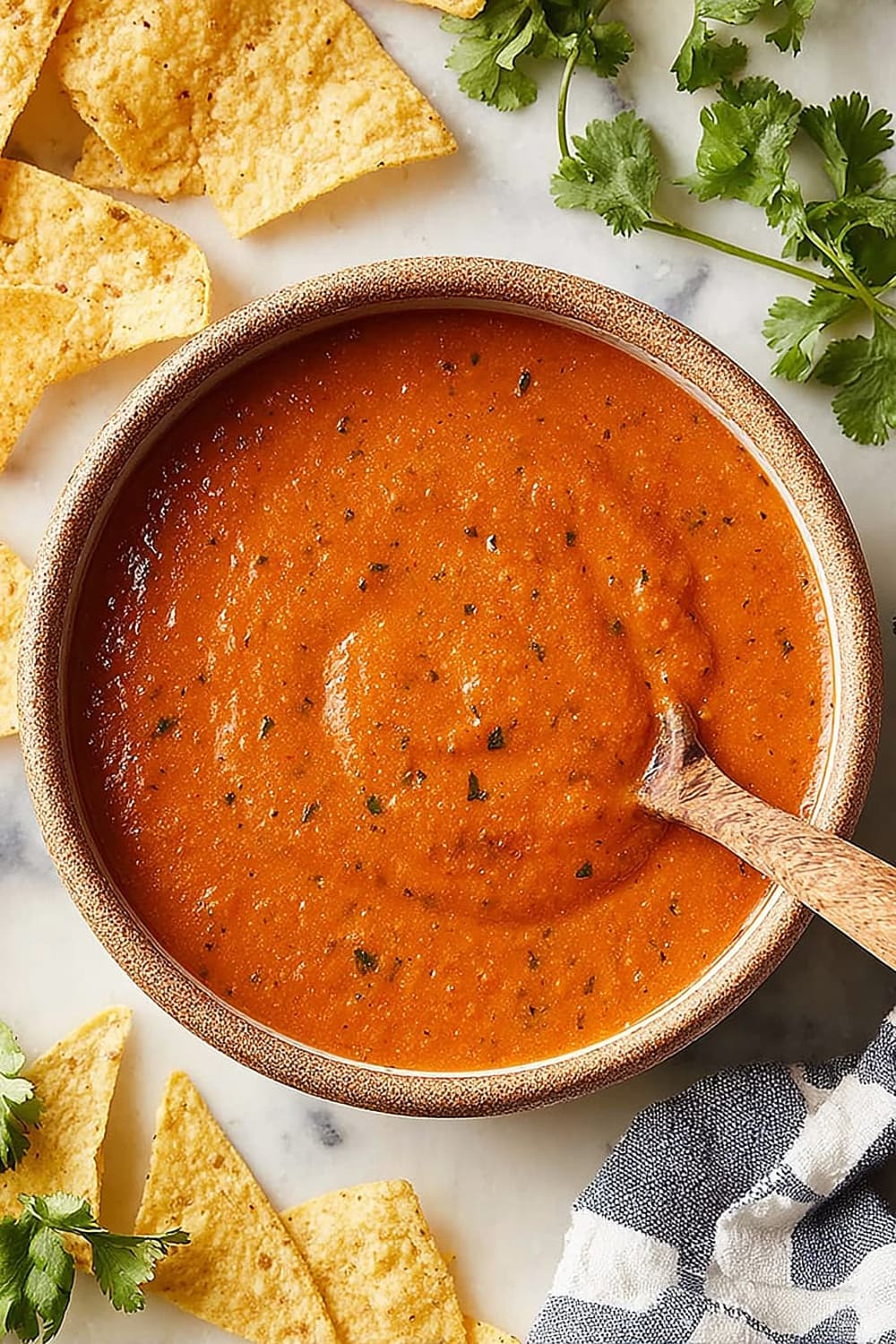
This ranchero sauce is about to become your secret weapon for turning any ordinary meal into a fiesta of flavor that’ll have everyone asking for the recipe.
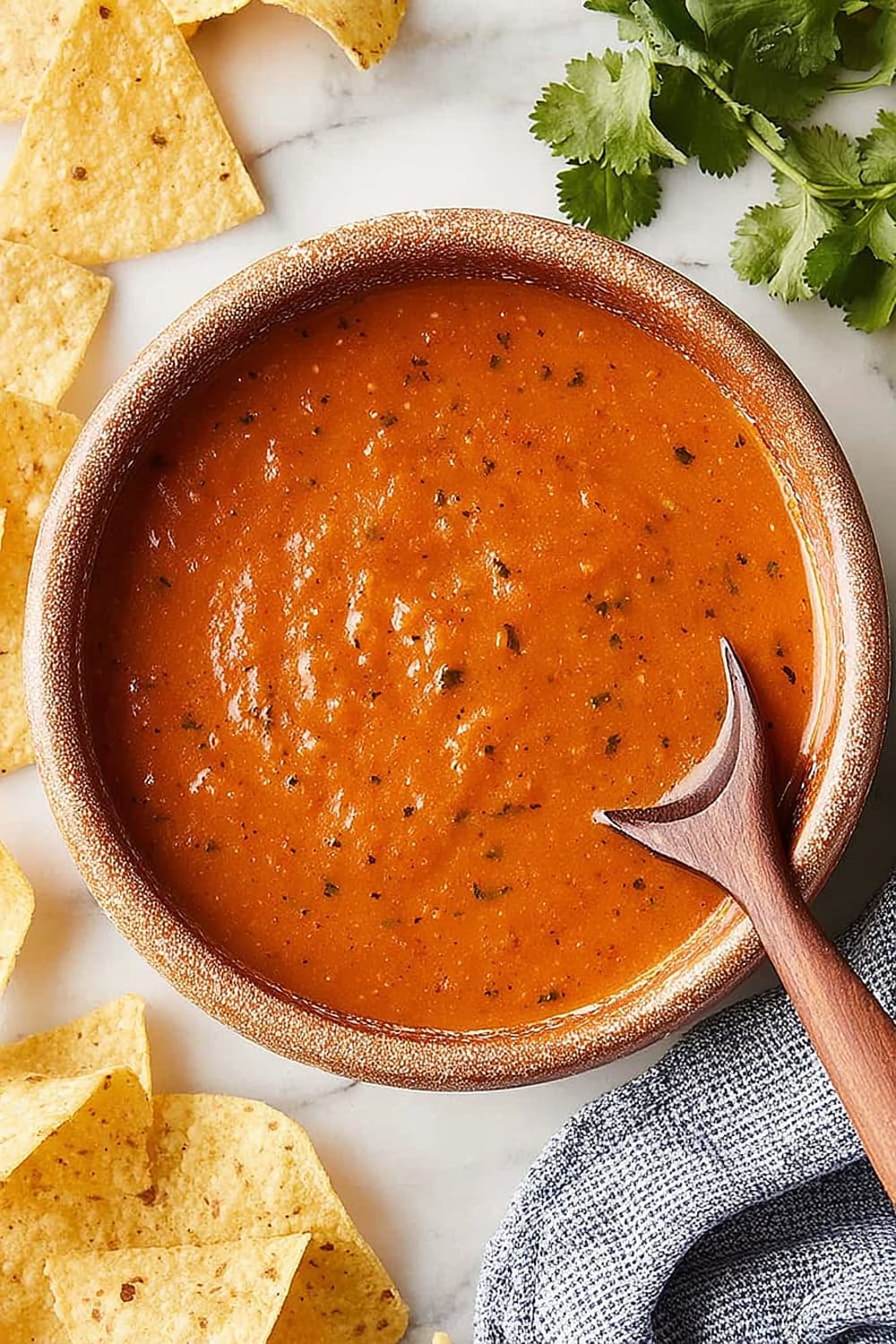
Made with fresh roma tomatoes, smoky chipotle peppers, and bright cilantro, this sauce delivers the perfect balance of heat and tang that makes your taste buds do a happy dance.
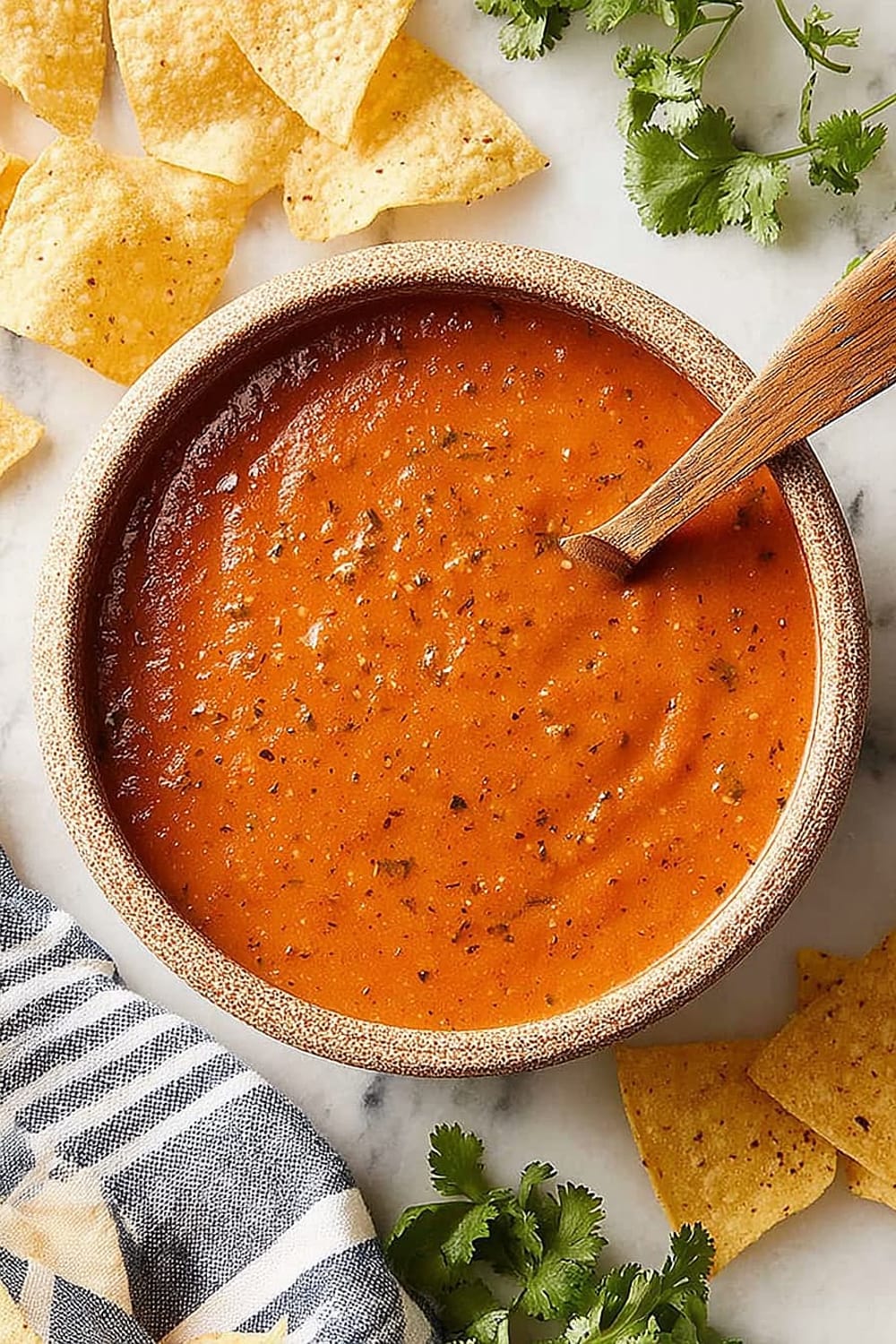
The beauty of this recipe lies in its simplicity – just sauté, simmer, and blend your way to restaurant-quality sauce that puts store-bought versions to shame.
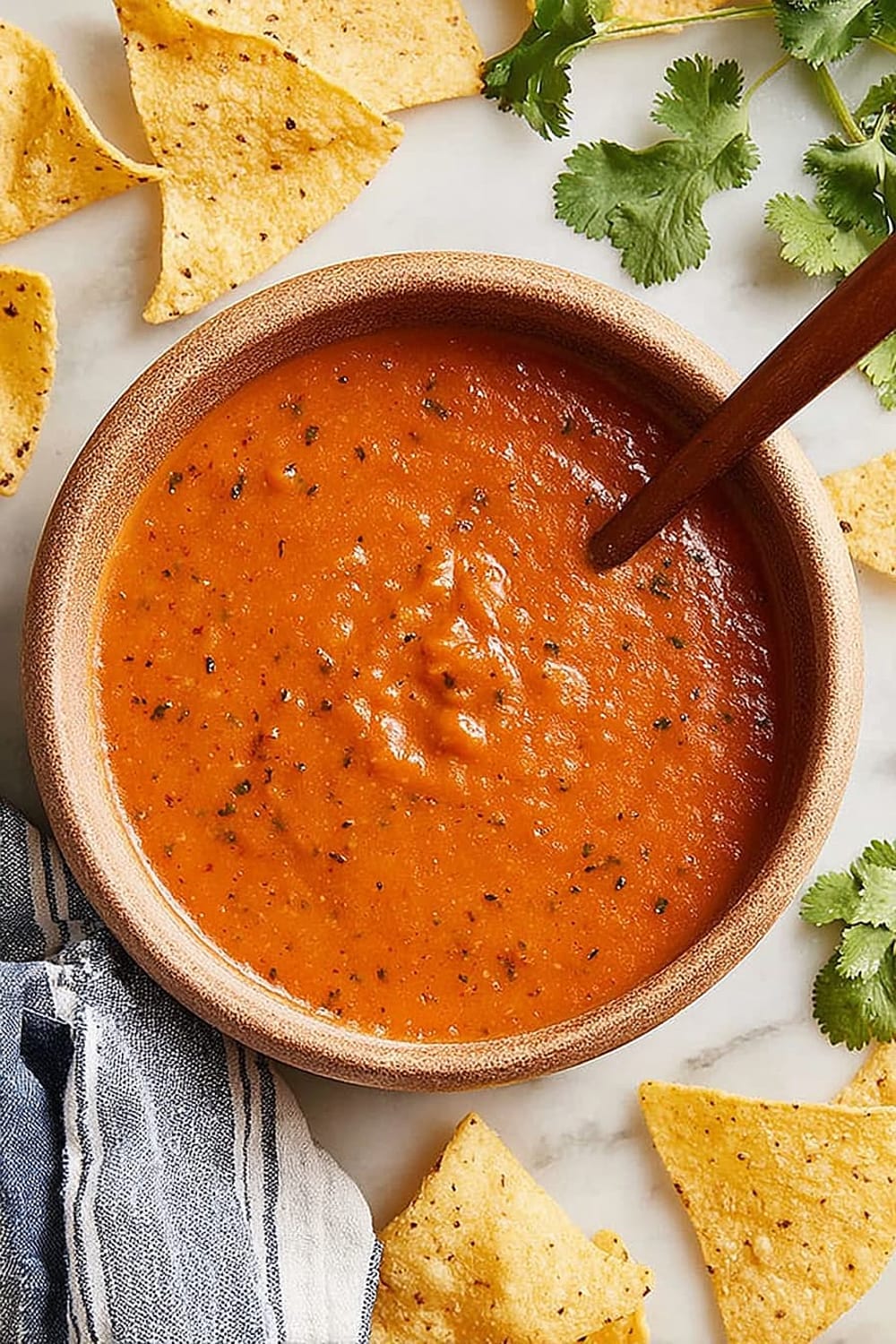
What makes this ranchero sauce special is the combination of fresh jalapeño heat with smoky chipotle depth, creating layers of flavor that complement everything from huevos rancheros to grilled chicken.
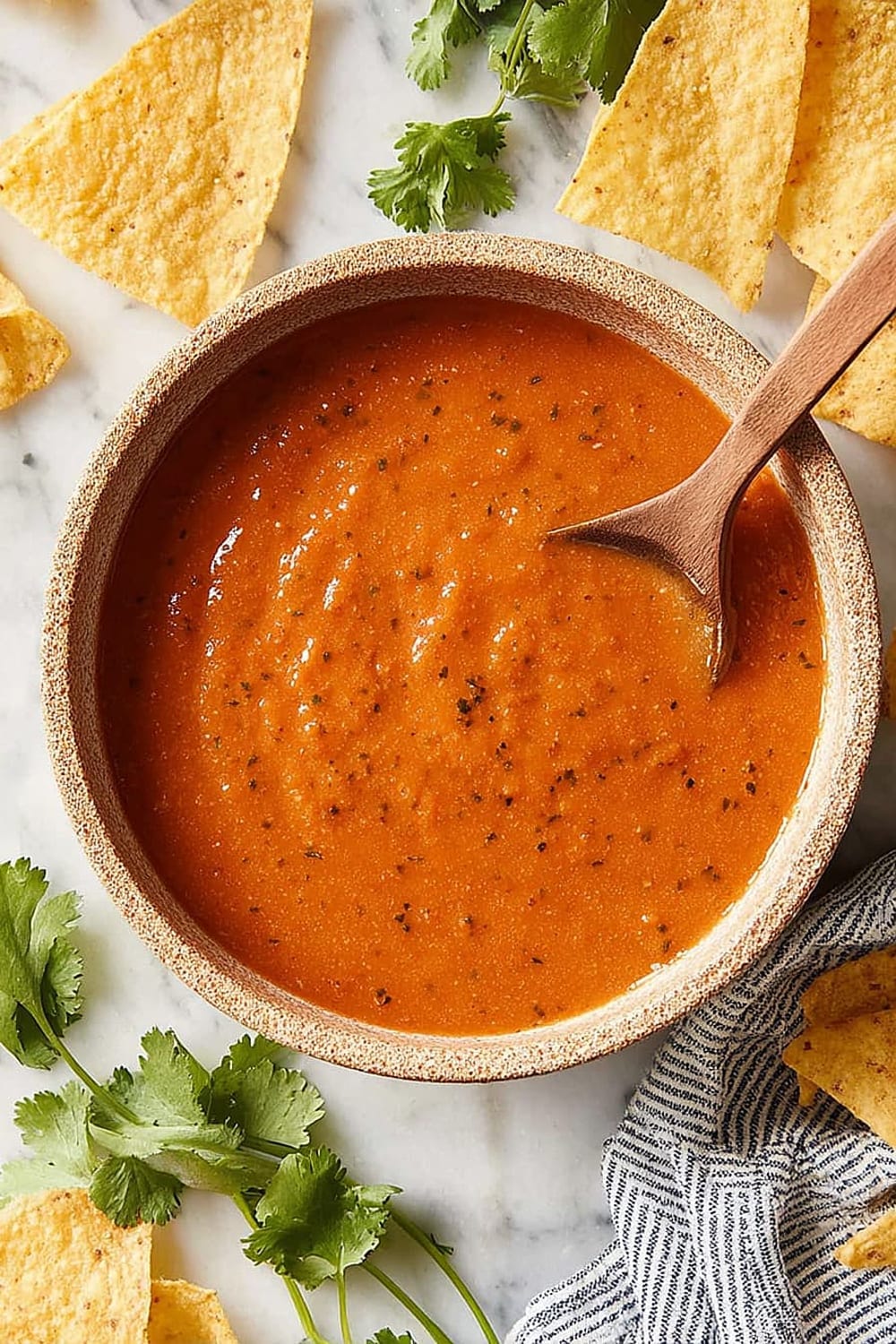
The immersion blender gives you complete control over texture, so you can keep it chunky for rustic appeal or blend it smooth for elegant drizzling.
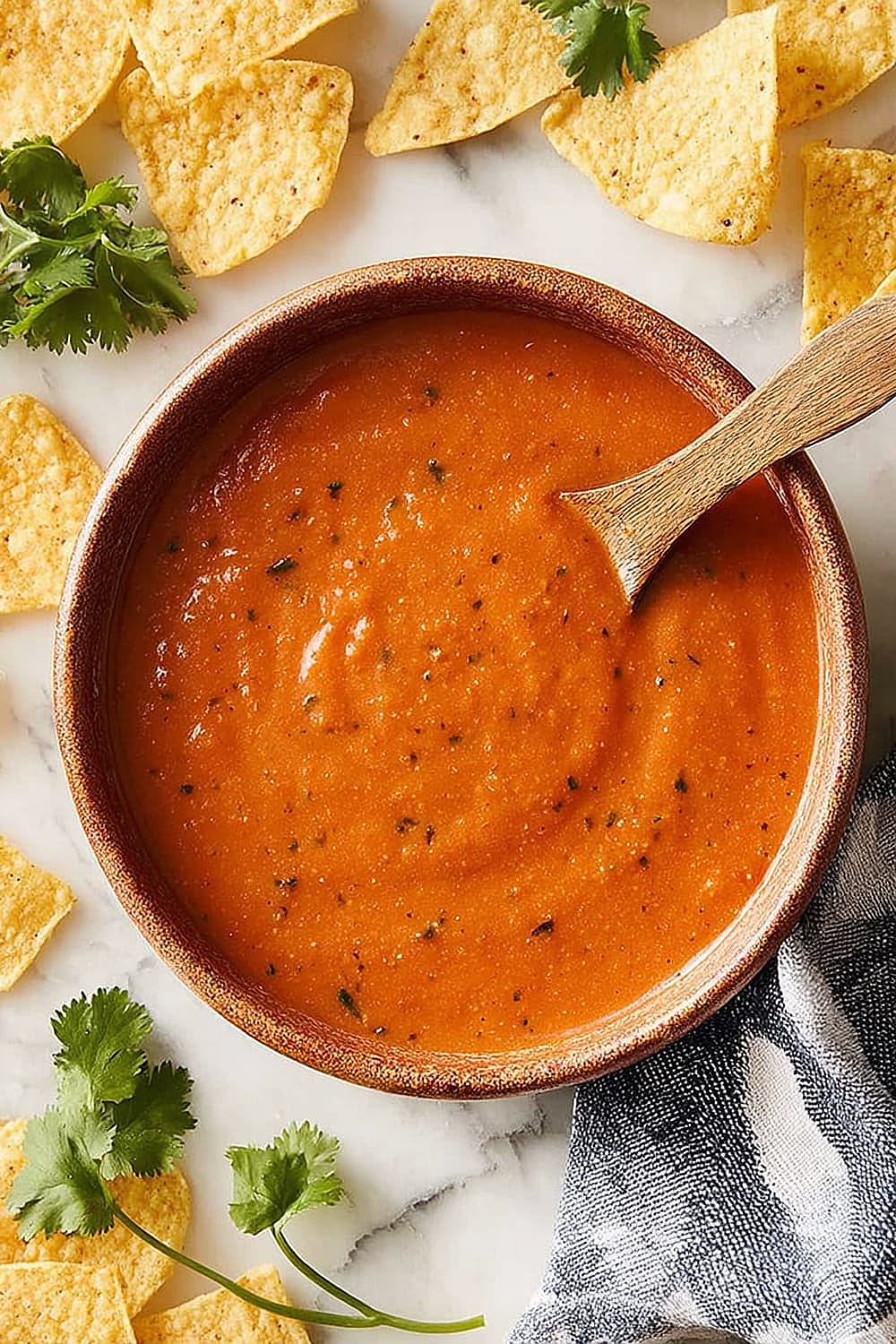
Best of all, this sauce keeps beautifully in the fridge for up to a week, meaning you can batch-make your way to effortless weeknight dinners that taste like you spent hours in the kitchen.
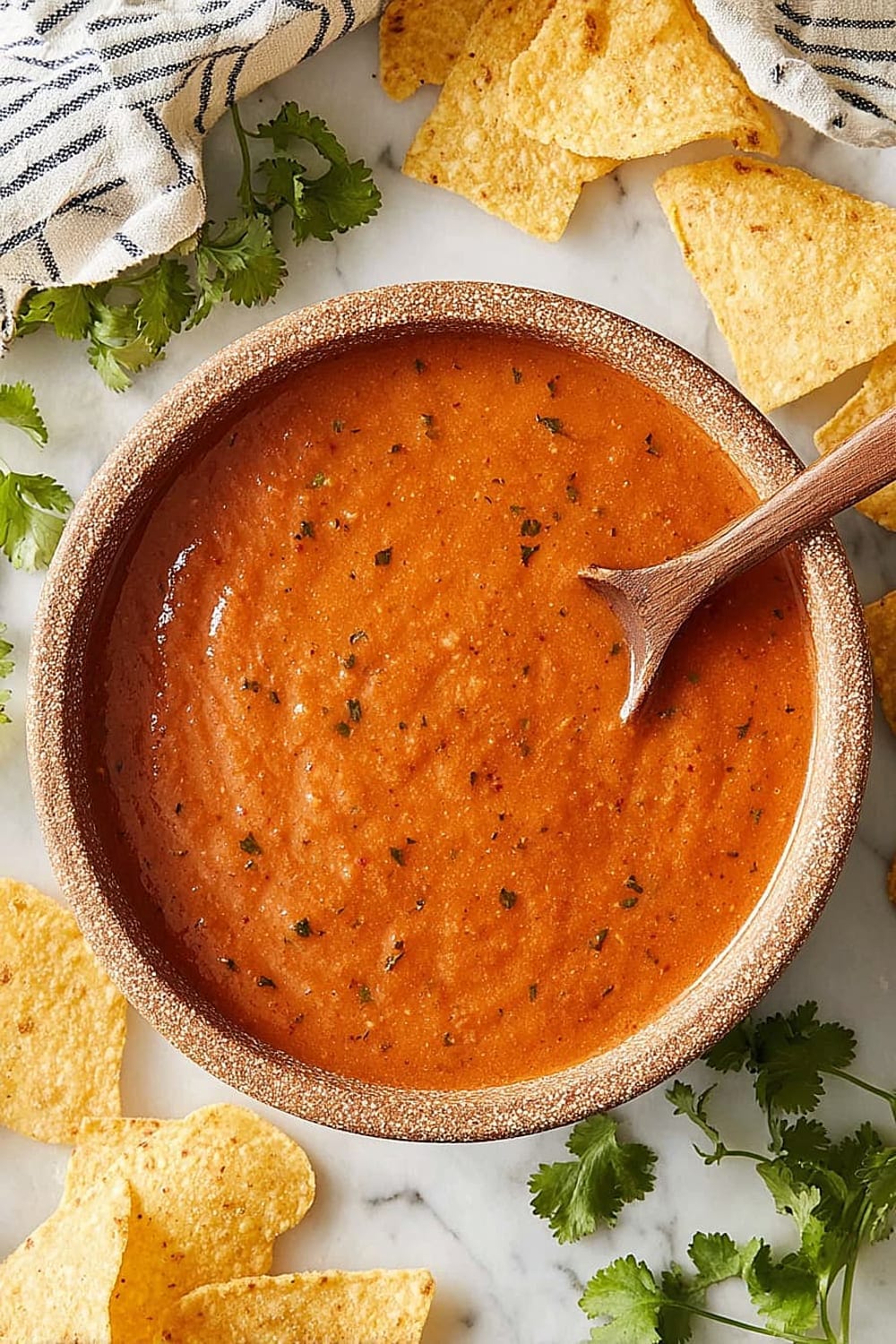
Ingredients
For the Sauce Base
- 1 tablespoon avocado oil
- ½ medium white onion, diced
- 4 roma tomatoes, chopped
- 1 jalapeño pepper, diced
- 1 chipotle pepper from a can of chipotles in adobo sauce, chopped
- 2 garlic cloves, chopped
For Seasoning
- ½ teaspoon dried oregano
- ½ teaspoon sea salt
- ½ cup vegetable broth
For Finishing
- ¼ cup chopped fresh cilantro
- 2 tablespoons fresh lime juice
- ½ teaspoon cane sugar, optional
Instructions
Prepare the Sauce Base
- 1 Heat the avocado oil in a small saucepan over medium heat until it shimmers slightly, about 1-2 minutes. The oil should move freely around the pan but not smoke.
- 2 Add the diced onion, chopped tomatoes, jalapeño, chipotle pepper, garlic, oregano, and salt to the heated oil. Cook, stirring occasionally with a wooden spoon or silicone spatula, for 10 minutes. The tomatoes should be completely softened and broken down, releasing their juices to create a chunky, saucy mixture.
Build the Flavor
- 3 Stir in the vegetable broth and cook for 1 additional minute, allowing the liquid to heat through and begin incorporating with the tomato mixture. The sauce should be bubbling gently at this point.
- 4 Remove the saucepan from heat immediately and stir in the fresh cilantro and lime juice. The residual heat will wilt the cilantro slightly while preserving its bright flavor and color.
Blend and Finish
- 5 Transfer the hot sauce mixture to a deep bowl or large mason jar to prevent splashing. Using an immersion blender, pulse and blend the sauce until it reaches a nearly smooth consistency while still maintaining some texture. You should see visible flecks of cilantro throughout, and the sauce should have a slightly chunky appearance rather than being completely pureed.
- 6 Taste the sauce carefully (it will be hot). If the sauce tastes sharp or overly acidic from the tomatoes and lime, add the ½ teaspoon cane sugar to balance the flavors. Stir well and taste again.
- 7 Allow the sauce to cool to room temperature, approximately 30 minutes, before transferring to an airtight container. Store in the refrigerator for up to one week. The flavors will continue to meld and improve after the first day of storage.
Recommended Equipment and Kitchen Tools
Essential Tools (for best results)
- Immersion blender – The Vitamix immersion blender provides perfect control over texture, allowing you to achieve that ideal nearly-smooth consistency without over-processing
- Small saucepan – A heavy-bottomed pan distributes heat evenly, preventing hot spots that could scorch the tomatoes
- Wooden spoon or silicone spatula – These won’t scratch your cookware and are perfect for stirring acidic tomato mixtures
- Deep bowl or large mason jar – Essential for safe blending with the immersion blender to prevent splashing
Helpful Upgrades
- Food processor or upright blender – Alternative blending options if you don’t have an immersion blender, though you’ll have less control over final texture
- Fine-mesh strainer – For those who prefer an ultra-smooth sauce, strain after blending to remove any remaining pieces
- Glass storage containers – Won’t absorb flavors or stains like plastic containers might with this vibrant, acidic sauce
Nice-to-Have Options
- Microplane grater – Perfect for zesting lime directly into the sauce for extra citrus brightness
- Kitchen scale – For precise measurements when scaling the recipe up or down for meal prep batches
Recipe Variations and Dietary Modifications
Heat Level Adjustments
- Mild version: Omit the chipotle pepper and remove seeds from jalapeño before dicing
- Extra spicy: Add an additional chipotle pepper or include ½ teaspoon of the adobo sauce from the can
- Fire version: Include a diced serrano pepper along with the jalapeño for serious heat lovers
Flavor Profile Variations
- Smoky version: Add ½ teaspoon smoked paprika along with the oregano for deeper smoke flavor
- Herb-forward: Replace half the cilantro with fresh Mexican oregano or add 1 tablespoon fresh epazote
- Citrus twist: Substitute orange juice for half the lime juice for a sweeter, more complex citrus note
- Roasted version: Char the tomatoes and jalapeño under the broiler before chopping for deeper, caramelized flavors
Dietary Adaptations
- Oil-free: Sauté the vegetables in vegetable broth instead of avocado oil, adding more broth as needed to prevent sticking
- Low-sodium: Use low-sodium vegetable broth and reduce salt to ¼ teaspoon, relying on lime juice and spices for flavor
- Sugar-free: Skip the optional cane sugar and balance acidity with an extra tablespoon of vegetable broth instead
Texture Variations
- Chunky salsa-style: Pulse the immersion blender just 2-3 times for a very rustic, chunky texture
- Smooth restaurant-style: Blend thoroughly and strain through fine-mesh strainer for silky smoothness
Nutritional Information and Health Benefits
Key Nutritional Highlights
This ranchero sauce provides approximately 25-30 calories per ¼ cup serving, making it a flavorful, low-calorie addition to any meal. The recipe yields about 2 cups total, giving you 8 servings of vibrant, nutrient-dense sauce. Each serving contains minimal fat from the avocado oil, moderate amounts of natural carbohydrates from the tomatoes and onions, and virtually no protein, making it an excellent complement to protein-rich dishes like eggs or grilled meats.
Health Benefits of Main Ingredients
The roma tomatoes provide lycopene, a powerful antioxidant that becomes more bioavailable when cooked, as in this recipe. They also contribute vitamin C, potassium, and folate. Jalapeño and chipotle peppers contain capsaicin, which may boost metabolism and provide anti-inflammatory benefits. The garlic offers allicin compounds known for their immune-supporting properties, while fresh cilantro provides vitamin K, vitamin A, and natural detoxifying compounds. Lime juice adds vitamin C and helps enhance iron absorption from other foods served alongside this sauce.
Dietary Considerations
This sauce is naturally gluten-free, dairy-free, and vegan (when made without the optional sugar or with plant-based sugar). It’s also low in sodium compared to commercial sauces, paleo-friendly, and fits into whole food, plant-based eating patterns. The minimal processing and fresh ingredients make it suitable for clean eating approaches, while the low calorie content supports weight management goals.
Smart Swaps and Ingredient Substitutions
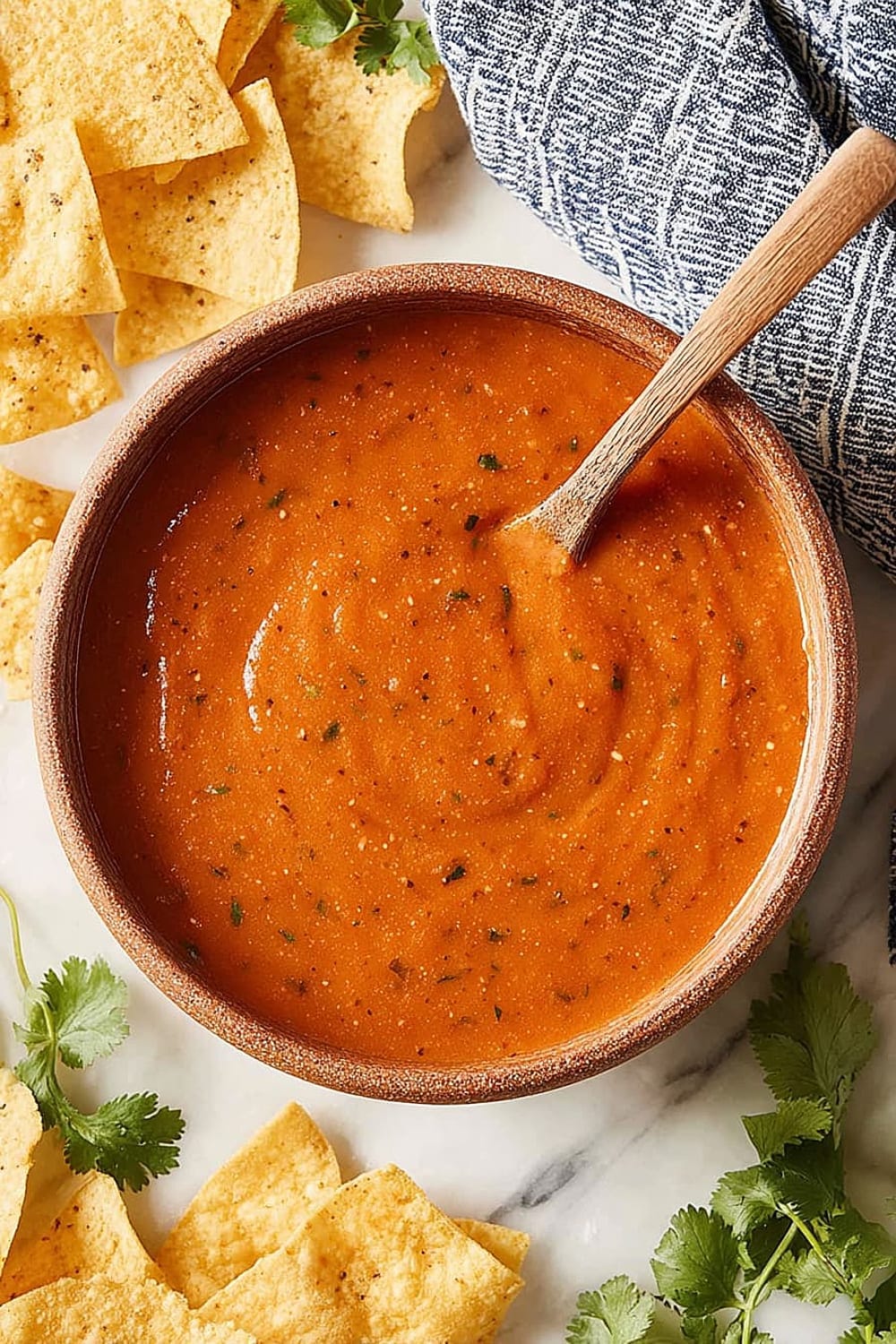
Common Substitutions:
- Roma tomatoes → Regular tomatoes (use 3 large) or 1 can (14.5 oz) diced tomatoes, drained
- Fresh jalapeño → ½ teaspoon red pepper flakes or 1 small serrano pepper for more heat
- Chipotle in adobo → ½ teaspoon smoked paprika plus ¼ teaspoon cayenne pepper
- Fresh cilantro → Fresh flat-leaf parsley (different flavor profile but still fresh and bright)
- Avocado oil → Olive oil, vegetable oil, or coconut oil
Budget-Friendly Swaps:
- Vegetable broth → Water with ½ teaspoon additional salt and a pinch of garlic powder
- Fresh lime juice → Bottled lime juice (though fresh provides better flavor)
- Sea salt → Regular table salt (use same amount)
Pantry Emergency Substitutions:
- Fresh garlic → ½ teaspoon garlic powder (add with the oregano)
- Fresh onion → 2 tablespoons onion powder or dried minced onion
- Dried oregano → 1 teaspoon fresh oregano or ½ teaspoon Italian seasoning
Pro Tips for Substitutions:
- When using canned tomatoes, reduce vegetable broth to ¼ cup since canned tomatoes contain more liquid
- If substituting dried herbs for fresh cilantro, use only 1 tablespoon and add at the beginning with the oregano
- Store leftover chipotle peppers in adobo sauce in the freezer in ice cube trays for future batches
Make It Diabetes-Friendly
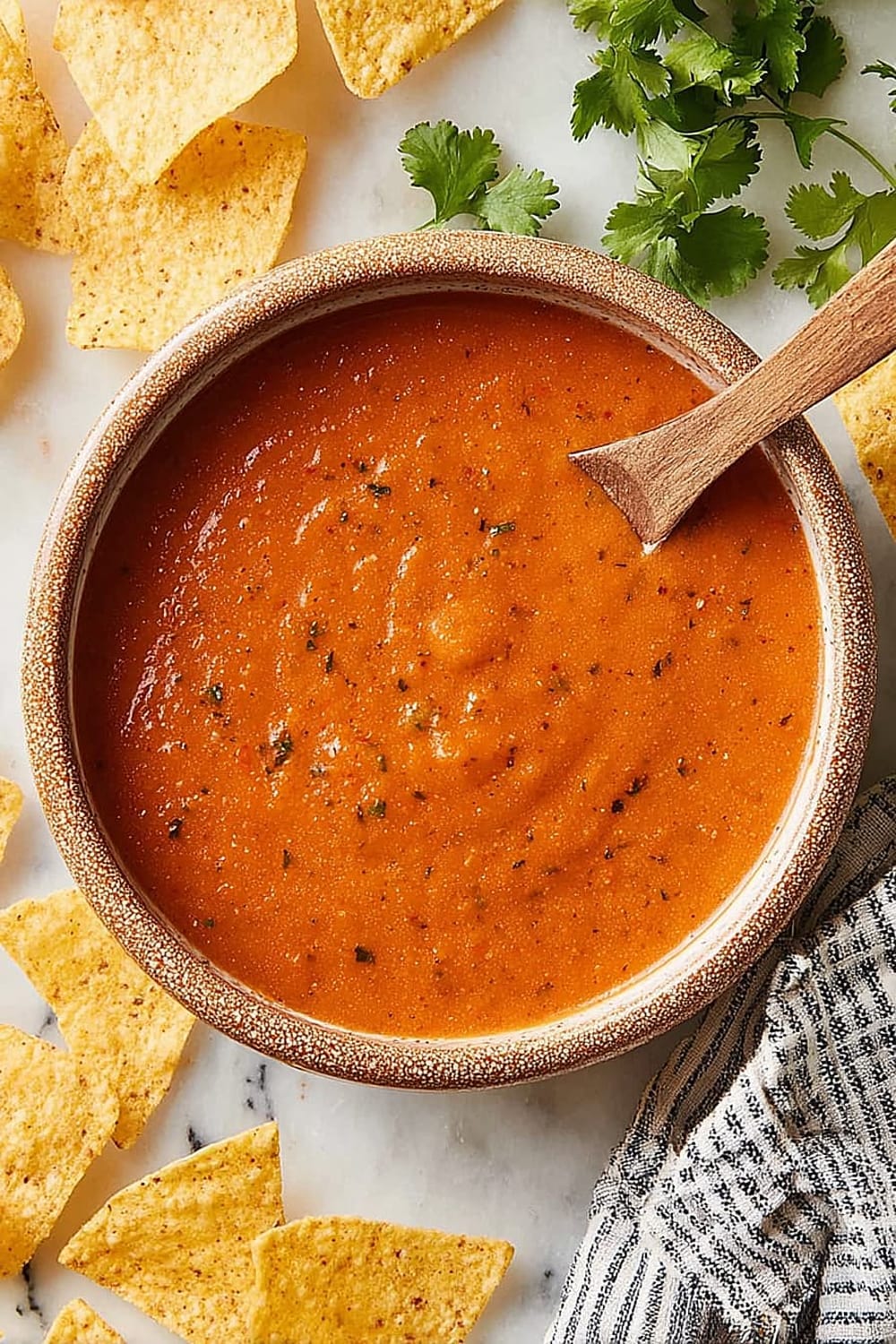
Sugar Modifications:
- Skip the optional cane sugar entirely – the natural sweetness from the tomatoes and onions provides sufficient balance
- If sauce tastes too acidic without sugar, add an extra 2 tablespoons of vegetable broth to mellow the flavors naturally
- Alternative natural sweeteners: Use ¼ teaspoon stevia or monk fruit sweetener if needed for balance
Carb-Conscious Serving:
- Estimated carbs per ¼ cup serving: Approximately 4-5 grams of carbohydrates, primarily from tomatoes and onions
- Portion control: Use 2 tablespoons per serving to reduce carbs to approximately 2-3 grams
- Pair strategically: Serve with high-protein, low-carb foods like scrambled eggs, grilled chicken, or cauliflower rice
Blood Sugar Friendly Tips:
- Fiber content: The vegetables provide fiber that helps slow sugar absorption
- Meal timing: Use as a condiment rather than consuming large quantities alone
- Protein pairing: Always serve with protein-rich foods to help stabilize blood sugar response
Total Carb Reduction: By omitting the optional sugar and using appropriate portion sizes, this sauce contains minimal impact carbohydrates while maximizing flavor.
Perfect Pairing Suggestions
Classic Mexican Dishes
This ranchero sauce shines brightest spooned over huevos rancheros with fried eggs and warm corn tortillas, but it’s equally spectacular with breakfast burritos, chilaquiles, or enchiladas. The bright acidity cuts through rich cheese and eggs beautifully, while the smoky heat complements traditional Mexican flavors. Try it drizzled over quesadillas or as a dipping sauce for crispy taquitos.
Protein Pairings
The sauce’s bold flavors make it an excellent companion for grilled chicken, pork tenderloin, or fish tacos. It works particularly well with scrambled or poached eggs for any meal of the day, and adds incredible depth to black bean and quinoa bowls. For plant-based options, serve over roasted cauliflower steaks or grilled portobello mushrooms.
Beverage Pairings
The sauce’s heat and acidity pair beautifully with Mexican lagers, wheat beers, or crisp white wines like Sauvignon Blanc or Albariño. For non-alcoholic options, serve with fresh agua frescas, sparkling water with lime, or cold-brew coffee for brunch applications. Horchata provides a cooling contrast to the sauce’s spice level.
Complete Meal Ideas
Build a weekend brunch spread with the sauce alongside scrambled eggs, avocado toast, and fresh fruit. For dinner, create a Mexican-inspired grain bowl with cilantro-lime rice, black beans, roasted vegetables, and this sauce as the flavor-packed finishing touch.
Pro Tips and Troubleshooting
Professional Techniques
Control the heat level by tasting the chipotle pepper before adding – some are significantly hotter than others. Save the adobo sauce from the chipotle can and freeze it in ice cube trays for future batches or other recipes. Char the vegetables under the broiler for 3-4 minutes before sautéing for deeper, more complex flavors that rival restaurant versions.
Common Mistakes to Avoid
Don’t rush the cooking process – those full 10 minutes of sautéing are crucial for breaking down the tomatoes and concentrating flavors. Avoid over-blending with the immersion blender, which can make the sauce too smooth and lose its rustic charm. Never add the lime juice while the sauce is still cooking on the stove, as the heat will make it taste bitter.
Storage and Make-Ahead
This sauce actually improves after 24 hours in the refrigerator as flavors meld together. Freeze in ice cube trays for convenient single-serving portions that keep for up to 3 months. Double or triple the recipe easily for meal prep – it scales perfectly and makes an excellent batch-cooking staple for busy weeks.
Troubleshooting Guide
If too spicy: Stir in an extra tablespoon of vegetable broth and a pinch of sugar. If too mild: Add a few drops of the adobo sauce from the chipotle can. If too thick: Thin with additional vegetable broth, one tablespoon at a time. If too thin: Simmer uncovered for 2-3 additional minutes to reduce liquid.